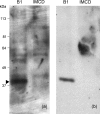Redistribution of the sheep neonatal Fc receptor in the mammary gland around the time of parturition in ewes and its localization in the small intestine of neonatal lambs
- PMID: 12423304
- PMCID: PMC1782797
- DOI: 10.1046/j.1365-2567.2002.01514.x
Redistribution of the sheep neonatal Fc receptor in the mammary gland around the time of parturition in ewes and its localization in the small intestine of neonatal lambs
Abstract
Maternal immunity is mediated exclusively by colostral immunoglobulins in ruminants. As the neonatal Fc receptor (FcRn) is suggested to be involved in the transport of immunoglobulin G (IgG) in the mammary gland, we cloned this receptor from sheep and analysed its expression in the mammary gland around the time of parturition and also in the small intestine from the newborn lamb. FcRn heavy-chain mRNA was detected (by using in situ hybridization) exclusively in the acinar and ductal epithelial cells in mammary gland biopsies both before and after parturition. Immunohistochemistry revealed that the cytoplasm of the epithelial cells of the acini and ducts in the mammary gland biopsies stained homogeneously before parturition. A remarkable difference was observed in the pattern after lambing, where the apical side of the cells was strongly stained. The presence of the FcRn in the acinar and ductal epithelial cells of the mammary gland, and the obvious change in distribution before and after parturition, indicate that the FcRn plays an important role in the transport of IgG during colostrum formation in ruminants. Immunohistochemical analysis detected a strong apical and a weak basal FcRn signal in the duodenal crypt cells of a neonatal lamb, which have been previously demonstrated to secrete IgG1 in newborn ruminants. The FcRn was not detected in the duodenal enterocytes, which absorb intact IgG from the colostrum in a non-specific manner. These data suggest that FcRn is involved in IgG1 secretion in ruminant epithelial cells.
Figures






References
-
- Butler JE. Immunoglobulins and immunocytes in animal milks. In: Ogra PL, editor. Mucosal Immunology. 2. New York: Academic Press; 1999. pp. 1531–54.
-
- Butler JE. Bovine immunoglobulins: an augmented review. Vet Immunol Immunopathol. 1983;4:43–152. - PubMed
Publication types
MeSH terms
Substances
LinkOut - more resources
Full Text Sources
Other Literature Sources
Research Materials

